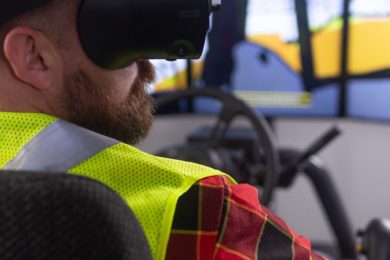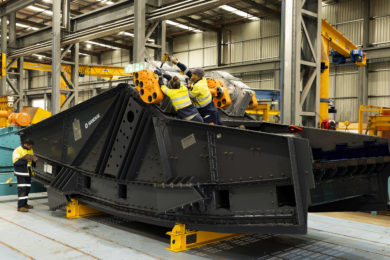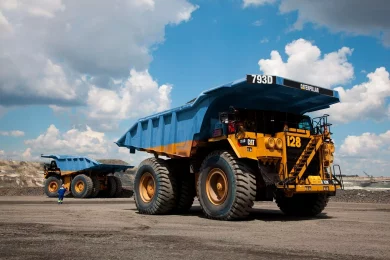Simformotion™ LLC is a privately held business headquartered in Peoria, Illinois, USA which was founded in 2009, and specialises in training technologies for industries such as mining where it is best known as the licensee for Cat® Simulators for Caterpillar Inc. The company recently spoke to IM about the importance of simulator-based training and how the latest technology can bring a competitive edge.
The company states: “Ask any owner, training manager or operator in the mining industry what their most important priorities are, and safety will top the list of considerations. Untrained or under-trained operators can cause a lot of damage to machines and surrounding personnel – not to mention the operator’s potential personal harm. Proper operator training is essential to reducing injury, property damage and even unplanned maintenance caused by machine misuse.”
Annette Kiesewetter, Simformotion Marketing Strategist: “Simulation training is not a new concept, but it is more widely adopted than ever before. Companies understand the importance of teaching and maintaining safety while still running a productive and efficient mining operation. Simulation has grown in popularity because it takes away the risks of training on actual machinery and pays for itself in additional ways. Simulation has morphed from basic controls functions into models that can simulate multiple dynamic machine applications, feature accurate physics, full body motion, VR integration – and the best simulators are built with authentic OEM controls.”
Models are available for many of the same machines seen on mine sites around the world. Operators can not only learn the controls but can also engage in collaborative worksite training with each other (two people operating simulated machines at the same virtual worksite), or practice how to respond in dangerous situations with incident response training. “Knowing what to do in a pressure situation before it happens, can save a life. Practicing in a virtual environment before getting on a real machine can benefit new hires and seasoned operators alike.”
“We use the Incident Response training to train operators how to respond to engine fires, loss of brakes, loss of steering and slick roads. All the situations you would like to duplicate in the field but can’t safely duplicate. A lot of companies just talk to their operators and tell them what to do in those situations. But you can’t see the operator’s reaction unless you’re using a simulator,” said Jerry Rynearson, Training Manager at Ledcor.
The virtual environment features a mine site so the operator can complete training exercises in many different situations from driving and hauling to loading and unloading – often interacting with other AI machines. Because operators can repeat difficult manoeuvres and safety procedures on the simulator as many times as needed, they can better retain the knowledge learned when behind the controls of the actual machines. “In addition, simulators help alleviate dangerous situations when operators aren’t yet familiarised with the actual heavy equipment by allowing operators to make mistakes in a virtual environment. From reminding operators to use three points of contact when entering a machine cab to buckling their seat belts before beginning operation, simulators underscore safety procedures so the operators perform them instinctively when in the cab of an actual machine.”
Other simulation includes VR and AR experiences (virtual and augmented realities), both of which are becoming more popular for training, with VR integrated into some simulator brands. Kiesewetter: “Another digital experience is companion curricula such as SimScholars™ available exclusively for Cat® Simulators systems. Both educational organisations and private businesses are discovering the benefits of adding additional theoretical learning to training with simulators. Subject-matter experts and licensed teachers work together to produce SimScholars™ curricula which works in tandem with Cat Simulator training. Understanding the ‘why’ behind the machine techniques and exploring machines and related environments, makes for a more rounded operator.”
Data feedback is an important part of simulator training today. Getting feedback, understanding ROI and delivering data to stakeholders is an expectation within mining companies. However, getting data can be a challenge. “Some simulations feature machine metrics/benchmarks as part of the systems. Cat® Simulators systems feature built-in software that provides a method to record and report user performance in each simulation session. The reporting software allows instructors/trainers to evaluate safety factors such as tracking collisions, improper braking, productivity, and more – all presented in a customisable dashboard for the instructor/trainer.”
“Some of our experienced excavator operators could not pass the simulator benchmarks at first, until we showed them what they were doing wrong (overloading the bucket, not setting up right and overloading trucks). After simulator training, the operators did a great job-saving wear and tear on the equipment. They took what they learned back into the field,” said Danny Turner, Training & Development Coordinator at Aecon Mining.
Simformotion concludes: “Training expectations are well beyond hoping the operator can become productive. Now, smart companies want a competitive edge and safe operators who do not cost the company lost productivity and machine downtime. By investing in technology like simulators, these companies get the positive results they need not only to remain competitive but also to keep their operators, mine site personnel and equipment safe.”










